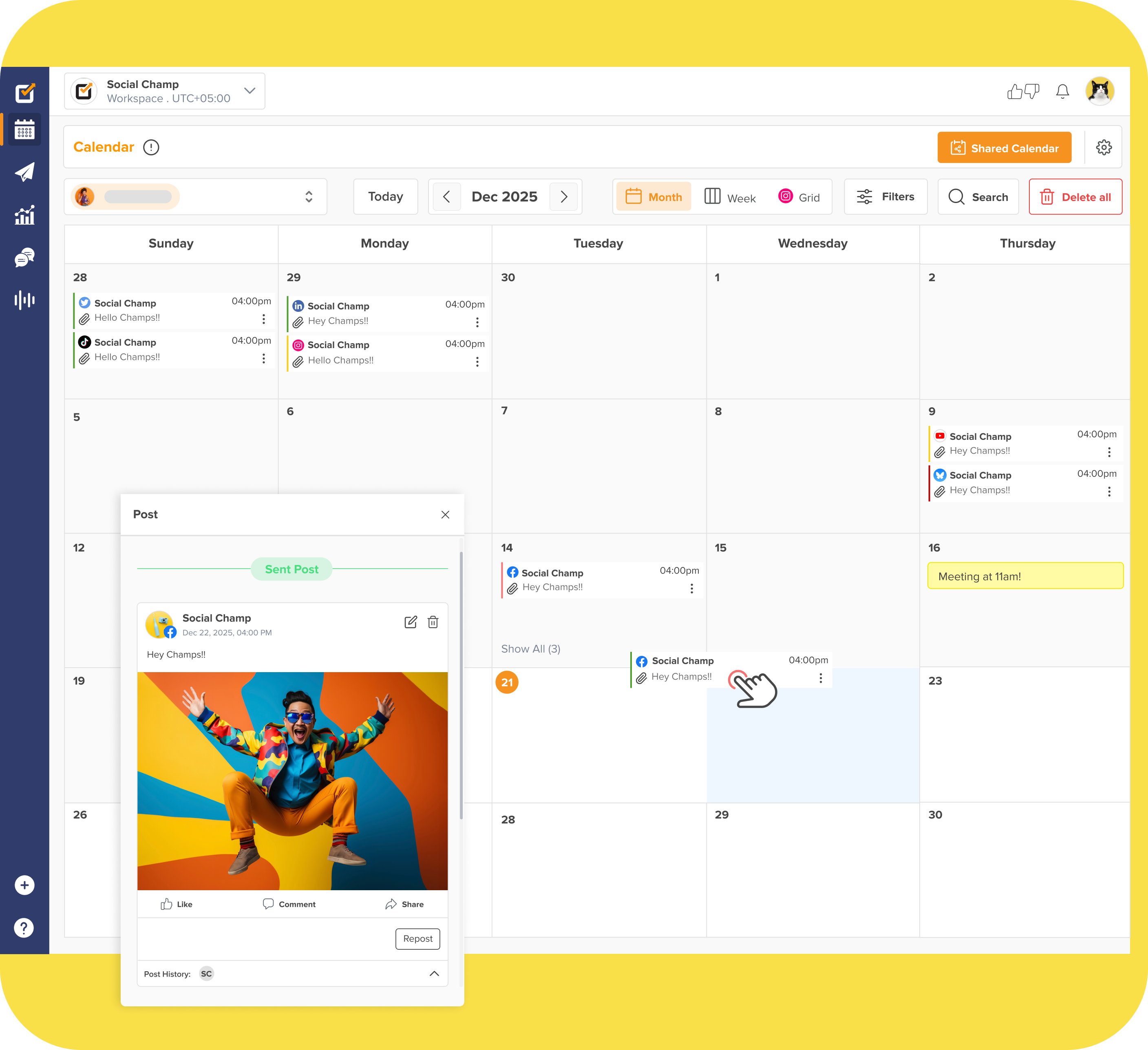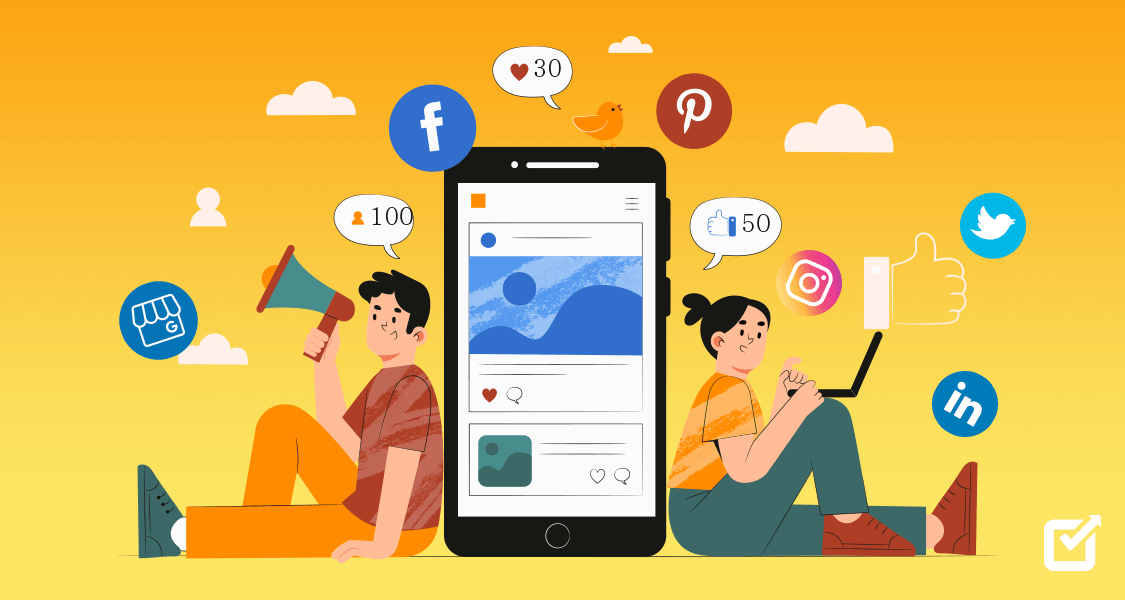Last month, a friend asked me about a charity organization they could donate to.
While I had a few names in mind, I decided to research a little more to ensure my friend’s donation made the most impact.
However, A quick Google and social media search made me realize something—most nonprofit organizations aren’t promoting themselves enough.
Either they underestimate the power of marketing or they aren’t utilizing the right marketing strategies for nonprofits in 2025.
Instead of digging through a long list of nonprofits, wouldn’t it be easier if the right organization was already top of mind when people want to donate?
So, I got to work and shortlisted 10 best marketing strategies for nonprofits and SMM tools you can use to boost awareness, attract donors, and amplify their impact.

Let Your Mission Be Heard!
Stay consistent, engage donors, and grow your nonprofit with Social Champ’s all-in-one social media toolkit. Start now!
Short Summary
- Nonprofits need strong marketing strategies to boost awareness, attract donors, and sustain long-term impact. A clear plan helps maximize outreach and engagement.
- Identifying and engaging the right audience ensures nonprofits reach supporters who are most likely to donate, volunteer, or spread awareness.
- Leveraging social media platforms increases visibility, builds community engagement, and helps nonprofits share their mission effectively.
- Tools like Social Champ streamline content scheduling and posting.
- Automation simplifies marketing efforts, saving time and ensuring consistency in messaging.
- SEO and blogging enhance online presence, making it easier for potential donors and volunteers to discover nonprofit organizations through search engines.
- Data-driven decision-making and cost-effective ad campaigns help nonprofits allocate resources wisely, maximize outreach, and improve engagement with supporters.
- Measuring and optimizing campaigns ensures continuous improvement, allowing nonprofits to refine strategies and achieve better results over time.
Why Nonprofits Need a Strong Marketing Strategy
Nonprofits often struggle with limited budgets, lack of awareness, and donor retention.
Unlike businesses that generate revenue through sales, nonprofits rely on continuous support from donors, volunteers, and grants.
However, without a clear marketing strategy, even the most impactful organizations can go unnoticed, making it difficult to secure the funding and engagement they need.
-
Boosting Visibility
One of the biggest challenges is visibility. Many nonprofits do incredible work but aren’t reaching the right audience.
Without consistent branding and messaging, potential donors may overlook them in favor of larger, more recognizable organizations.
A strong marketing strategy ensures nonprofits can effectively communicate their mission, stand out in a crowded space, and attract the right supporters.
-
Encouraging Donor Trust
Another major hurdle is donor trust and engagement. People want to see where their contributions are going and how they’re making a difference.
Without compelling storytelling and regular updates, nonprofits risk losing donor interest.
A well-planned strategy uses content marketing, social media, and email campaigns to build relationships and keep supporters invested in the cause.
-
Cost-Effective Alternative to Traditional Marketing Practices
Resource constraints also make marketing challenging. Many nonprofits don’t have dedicated marketing teams or the latest tools to manage campaigns efficiently.
Leveraging cost-effective digital marketing solutions, automation tools, and AI-powered platforms can help streamline efforts, maximize outreach, and drive engagement without stretching resources too thin.
A nonprofit’s impact is only as strong as its ability to reach and inspire people.
Solid marketing strategies help nonprofits overcome these pain points, turn awareness into action, secure consistent funding, and ensure long-term success.
Featured Article: The Essential Guide to Modern Social Media: Trends, Tools, and Strategies for 2025
10 Powerful Marketing Strategies for Nonprofits
If you are a part of a nonprofit organization in 2025 and struggling with visibility and donor aid, you need to make some serious changes to your marketing plan.
Good for you, I have rounded up 10 best marketing strategies for nonprofits that will work for you in 2025 and most likely for the years to come.
-
Identify and Engage the Right Audience
There are several types of nonprofits, for example, social welfare nonprofits, religious institutions, advocacy organizations, political organizations and charities.
All these nonprofits cater to or require support from different communities or groups. Depending on these audiences, the “what” and “how” of your marketing message completely changes.
A message that might appeal to one group might not appeal to another. For example, if you want donations for a church, you cannot go to ask for support from a secular humanist organization,
That’s why the first step in building the best marketing strategies for nonprofits is always identifying and engaging the right audience.
Who knows, this is exactly where you were going wrong?
-
Leverage Social Media for Maximum Impact
The next step in your marketing plan is ensuring social media presence.
From Facebook and Instagram to Twitter/X and Linkedin, you need to maintain active social media accounts to increase your visibility and engage your audience.
Utilize viral trends, influencer marketing, and different types of content marketing to tell people about your cause and build a community.
Platforms like Instagram and Facebook are ideal for emotional storytelling, while LinkedIn can connect nonprofits with corporate sponsors.
Social media serves as a perfect platform for nonprofits to share real-time updates, start campaigns, and most importantly cost-effectively market their organization.

Instagram post from a Nonprofit Organization -
Automate and Simplify Marketing Efforts
Look, I get it, you are a nonprofit organization. You want to work for your cause and not waste time managing tedious marketing tasks.
But the real setback is, you also can’t afford a marketer right now.
So what do you do in this case?
Like there’s a solution to every problem, there’s marketing automation software for every overwhelmed business or non-business owner.
There are countless automation software, including Mightycause, that simplify your marketing efforts and reduce manual labor by a huge percentage.
For example Social Champ – an all-in-one tool for managing social media marketing. With this tool, you get to create, plan, schedule, analyze, and leverage social listening for all your social media accounts.
Similarly, you have Canva which makes simple graphic designing tasks a piece of cake, Textedly which offers an easy-to-use texting service, especially for nonprofits, and Drip, through which you can manage your email marketing effortlessly.

Social Champ’s Dashboard -
Create High-Impact Content That Drives Donations
Storytelling is at the heart of nonprofit marketing.
People connect with emotions, not just facts. Instead of simply stating statistics, nonprofits should share real stories about the people they help.
A video showcasing a child receiving an education through donor contributions or a heartfelt blog post about a rescued animal can be far more impactful than generic fundraising appeals.
Engaging visuals, testimonials, and behind-the-scenes content can turn casual supporters into lifelong donors.
-
Use SEO and Blogging to Increase Visibility
Most donors begin their journey with a Google search. If your nonprofit isn’t ranking on the first page, you’re missing potential supporters.
Blogging about topics like “how to choose a charity to donate to” or “best ways to support local nonprofits” can attract organic traffic and establish your organization as a thought leader.
Using targeted keywords, optimizing website content, and earning backlinks from reputable sites all boost search rankings.
SEO isn’t just for businesses—it’s a powerful tool that helps nonprofits get discovered by people actively looking to make a difference.

Blog Page of a Nonprofit Organization -
Email Marketing & Community Engagement
Email marketing remains one of the most effective ways for nonprofits to nurture relationships. A well-timed email can mean the difference between a one-time donor and a lifelong supporter.
Sending personalized updates, impact reports, and exclusive behind-the-scenes content makes donors feel valued.
Instead of generic mass emails, segmenting lists based on donation history or volunteer involvement ensures that supporters receive content relevant to them, increasing engagement and retention.
-
Data-Driven Decision-Making
Every marketing dollar counts, so nonprofits must track what’s working and what’s not.
Analytics tools help measure the effectiveness of campaigns, identify audience preferences, and optimize your best marketing strategies for nonprofits.
If social media ads drive more donations than email campaigns, shifting resources accordingly can maximize ROI.
Tools like Google Analytics, Facebook Insights, and Social Champ’s analytics features provide real-time data to refine outreach efforts and ensure every effort contributes to meaningful results.

Social Champ’s Analytics Feature -
Running Cost-Effective Ad Campaigns
Paid advertising might seem out of reach for nonprofits, but platforms like Google Ad Grants offer up to $10,000 per month in free advertising.
Running targeted Facebook and Instagram ads can also be highly effective in reaching potential donors and volunteers.
The key is to create compelling ads that highlight impact—such as “$25 feeds a homeless child for a week” rather than generic donation requests.
Smart ad targeting ensures that nonprofits reach people who are already interested in supporting similar causes.
-
Building Partnerships and Collaborations
Collaboration amplifies impact. Partnering with businesses, influencers, and other nonprofits expands reach and strengthens credibility.
A nonprofit focused on clean water access might collaborate with eco-conscious brands or local governments to fund projects.
Businesses often seek CSR (Corporate Social Responsibility) partnerships, providing nonprofits with sponsorships, donations, and wider visibility.
Strategic alliances help nonprofits tap into new audiences and gain valuable resources. The finest example of this is the collaboration between the nonprofit organization Wings for Life and Red Bull.

Homepage of Red Bull’s CSR Wings for Life World Run -
Measuring Success and Optimizing Campaigns
Marketing isn’t set-and-forget. Successful nonprofits continuously track, analyze, and refine their strategies.
Reviewing donor engagement metrics, social media performance, and campaign effectiveness helps identify what’s driving results and what needs tweaking.
If an email campaign has low open rates, adjusting subject lines or content formatting can improve performance.
Constantly optimizing efforts can help you ensure that all your best marketing strategies for nonprofits translate into tangible impact.
Featured Article: Discover the Best Times to Post on TikTok in 2025
5 Non Profit Organizations That Are Nailing Their Marketing Game
Here are a few examples of non profit organizations that are actively working on their marketing to make their names:
-
Charity: Water
Charity: Water has revolutionized nonprofit marketing through transparency and storytelling.
They operate on a 100% model, ensuring that all public donations directly fund clean water projects, with operational costs covered by private donors.
This approach builds trust and encourages more contributions. Their campaigns often feature personal stories and vivid imagery, making the impact of donations tangible.
Their Sleep For Water campaign is truly one of a kind and compels donors in a unique way to give for their cause.

Homepage of Charity; Water’s Sleep For Water campaign -
American Red Cross
The American Red Cross employs integrated marketing strategies to maintain a strong public presence. They utilize direct mail, print media, transit ads, and web banners, driving audiences to their website.
Their partnerships with corporations for cause marketing campaigns enhance brand visibility and demonstrate community commitment.
Additionally, their active engagement on social media platforms and unique style help attract, retain, and convert supporters.

IG post of a nonprofit -
World Wildlife Fund (WWF)
WWF effectively uses striking visuals and storytelling to raise awareness about conservation issues.
Their campaigns often feature compelling images of wildlife and natural habitats, evoking emotional responses that drive engagement and support.
Leveraging social media platforms and seeking donations by triggering emotional responses from its target audience, WWF extends its reach and mobilizes a global community of supporters.

Screenshot from WWF’s Symbolically Adopt an Elephant campaign -
St. Jude Children’s Research Hospital
St. Jude utilizes a multi-channel marketing approach to share patient stories and emphasize their mission of providing free treatment to children with serious illnesses.
Through emotional storytelling in advertisements, social media, and fundraising events, they create a strong connection with their audience.
Their transparent communication about how donations are used builds trust and encourages ongoing support.
Meanwhile they also utilize video marketing strategies to further expand their reach and increase awareness.

St. Jude Children’s Research Hospital’s YouTube Channel -
Automate and Simplify Your Marketing Efforts
Nonprofits operate in a world where every second and every dollar counts. With small teams and limited budgets, managing marketing efforts manually can be overwhelming.
Between social media posting, email campaigns, donor outreach, and event promotions, marketing often takes a backseat to the core mission.
However, automation can change that.
By streamlining repetitive tasks, your nonprofit organization can maintain a strong digital presence, engage with supporters, and focus on what truly matters—making an impact.
-
Save Time With Social Champ’s Automation Tools
One of the biggest challenges nonprofits face is keeping their social media accounts active.
Posting manually every day is time-consuming, and missing a post can lead to decreased engagement.
Social Champ allows nonprofits to schedule posts in advance, ensuring a steady flow of content without constant monitoring.
Instead of logging in multiple times a day to post updates, nonprofits can plan their content weeks or even months ahead, freeing up time for fundraising, outreach, and on-ground activities.
This ensures that no opportunity to engage with supporters is missed, even on the busiest days.
Additionally, Social Champ’s bulk scheduling feature allows nonprofits to upload and schedule multiple posts at once, making content planning seamless.
Whether it’s a series of donor appreciation posts, volunteer spotlights, or event countdowns, nonprofits can plan campaigns effortlessly without the need for daily intervention.
-
Effortless Content Scheduling and Consistency
Consistency is key in nonprofit marketing. A sporadic posting schedule can lead to decreased visibility, lower engagement, and missed fundraising opportunities.
Social Champ helps nonprofits maintain a reliable posting schedule across all platforms, ensuring that their message reaches the right audience at the right time.
While regular posting is mandatory, it is also true that being a nonprofit, especially a charitable organization, you can’t have something new to post every day.
Social Champ solves this problem too!
With the Repurpose feature, you can easily recycle important content without manually reposting it every time.
-
More Time for Impactful Work
The true benefit of automation isn’t just saving time—it’s about using that time effectively.
Instead of spending hours crafting and posting content, nonprofits can focus on meaningful engagement, such as responding to donor inquiries, building relationships with sponsors, and improving fundraising strategies.
Moreover, Social Champ’s analytics tools provide valuable insights into content performance.
Nonprofits can see which posts generate the most engagement, track follower growth, and refine their strategy based on real data.
This ensures that every marketing effort is backed by insights, leading to better results with less effort.

Struggling to Get Your Nonprofit Noticed? We Can Help!
Use Social Champ to plan and schedule your posts in advance, ensuring the right message reaches the right people at the right time.
Conclusion
Well-planned and at the same time well-executed marketing strategies for nonprofits allow nonprofits to connect with the right people, secure more donations, and create lasting impact.
Digital tools make it easier to reach potential supporters through social media, SEO, email marketing, and automation.
Streamlining efforts with platforms like Social Champ not only saves time but also ensures consistency across all marketing channels.
Meanwhile, maintaining a clear and compelling message across all platforms strengthens visibility and fosters long-term relationships with donors and supporters.
Organizations that embrace these strategies can maximize their impact and build a loyal community dedicated to their cause.













